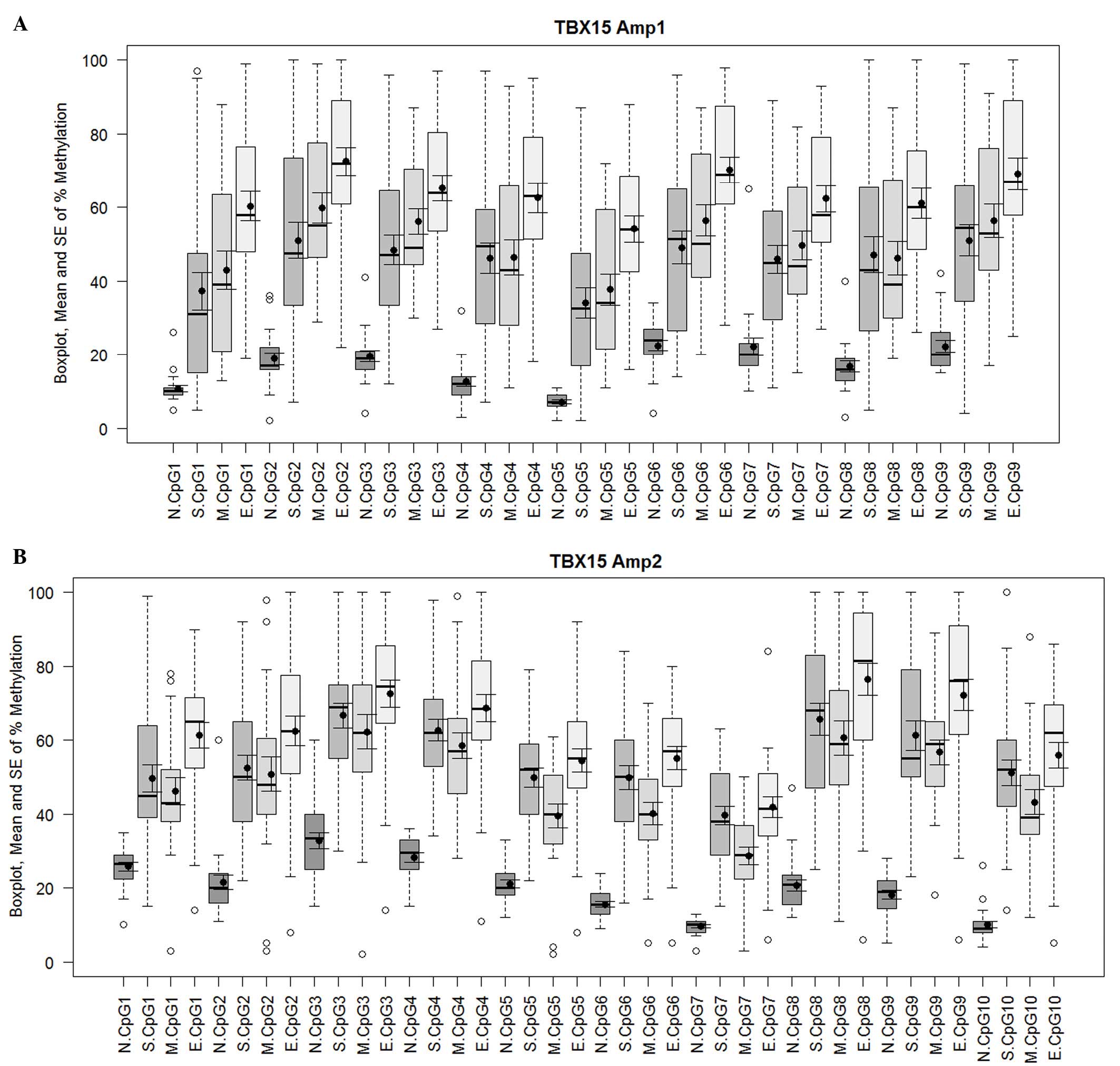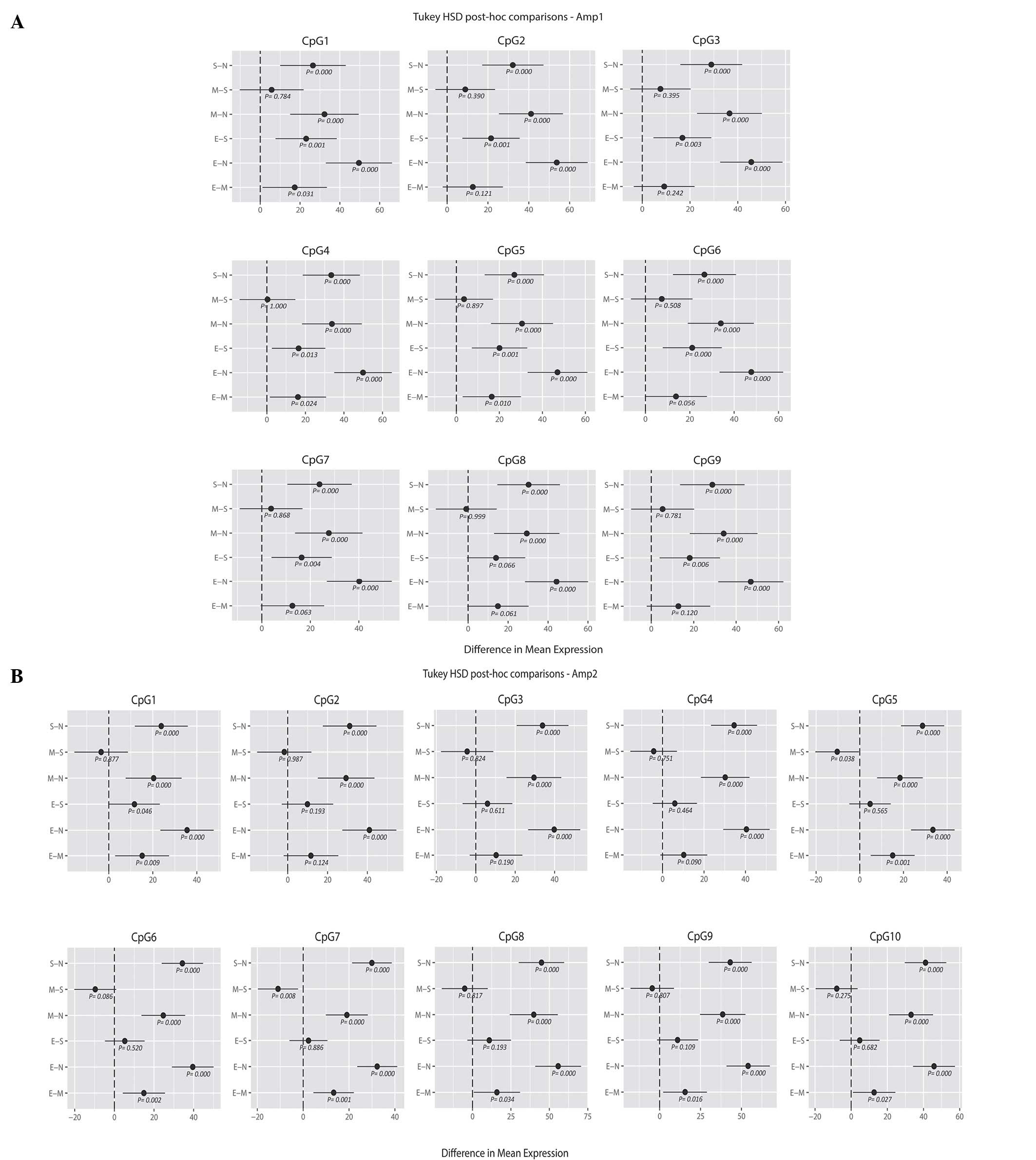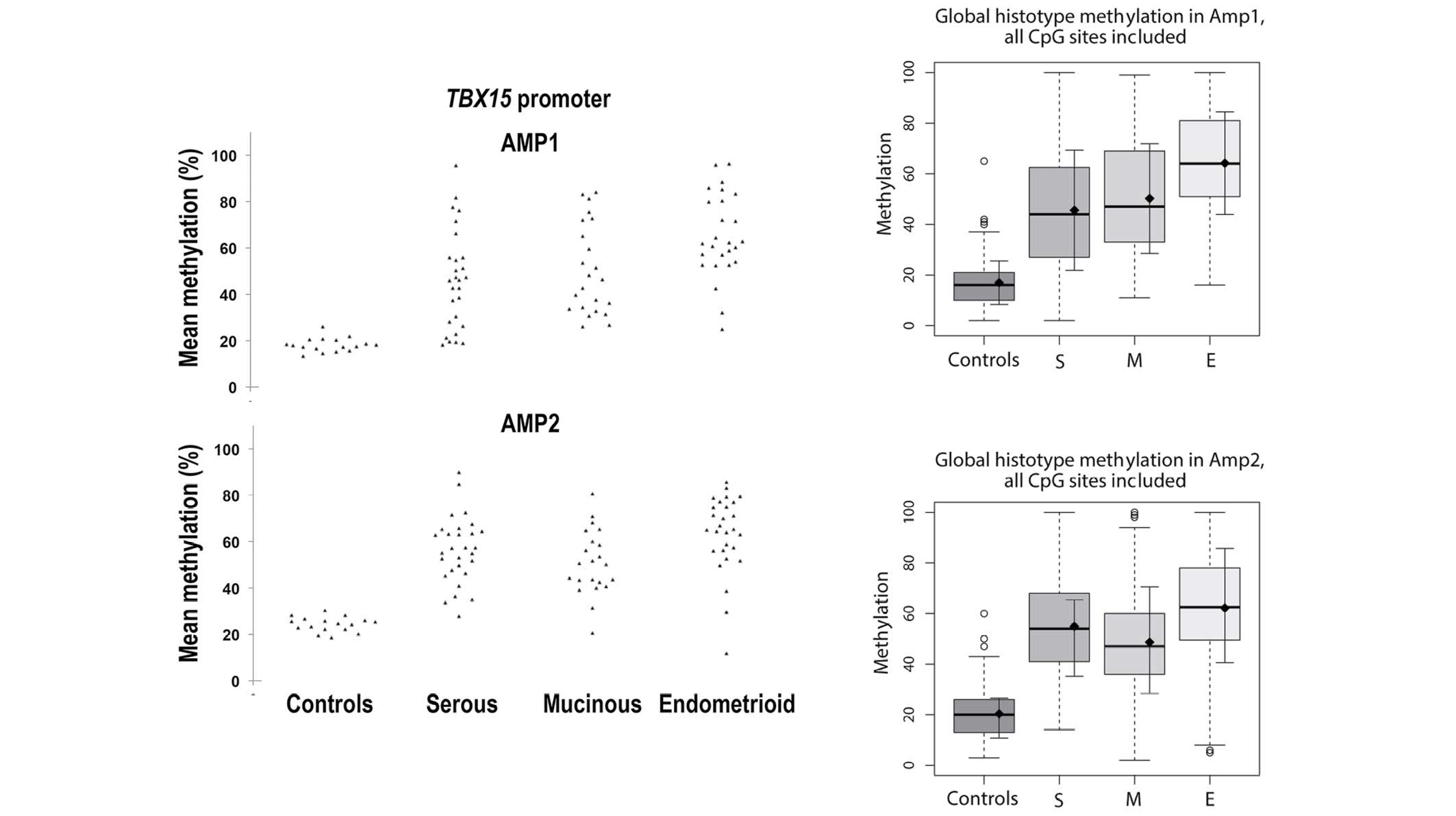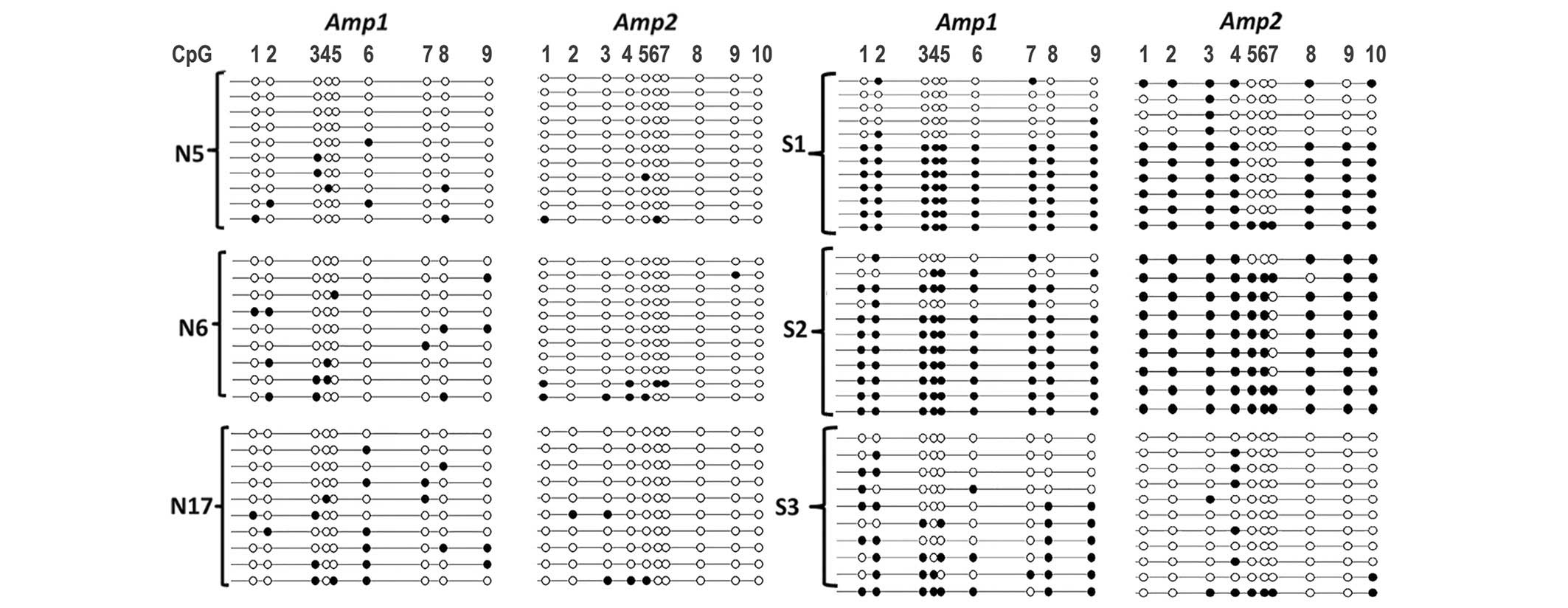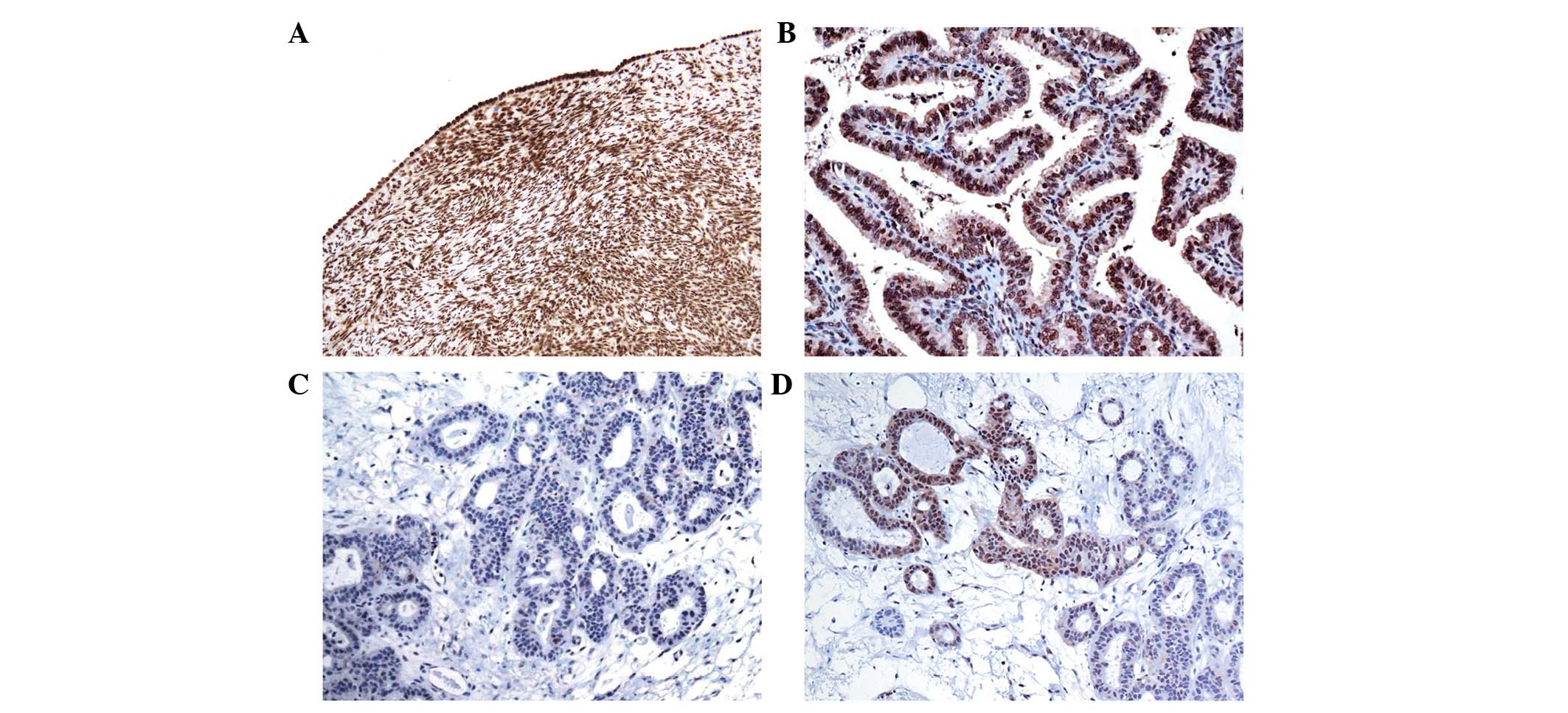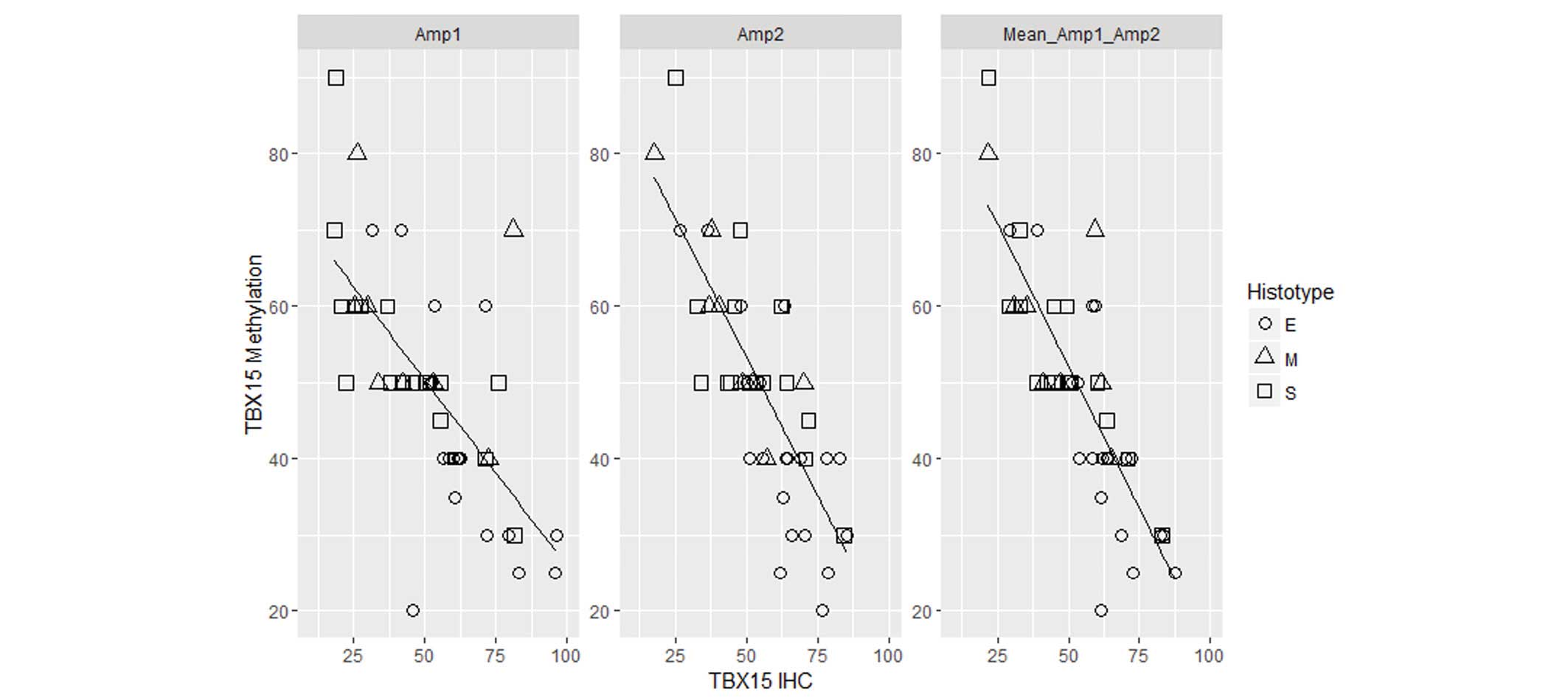Promoter methylation and downregulated expression of the TBX15 gene in ovarian carcinoma
- Authors:
- Published online on: August 16, 2016 https://doi.org/10.3892/ol.2016.5019
- Pages: 2811-2819
Abstract
Introduction
Ovarian cancer is the fourth most common type of cancer in the female genital tract, but has the highest mortality rate of all gynecological tumors. Ovarian carcinoma accounts for >90% of cases of ovarian cancer and may arise from relatively pluripotent cells of the coelomic epithelium or ‘modified mesothelium’ that covers the ovary (1). The coelomic epithelium is the mesodermal-derived epithelial lining of the intraembryonic coelom that invaginates to give rise to the mülllerian ducts, the primordia for the epithelia of the fallopian tube, the endometrium and the endocervix (1). There is now compelling evidence that certain carcinomas can also originate from the fallopian tubes and the endometriosis (1,2). Ovarian carcinoma are a heterogeneous group of neoplasms that exhibit a wide range of tumor morphologies and clinical manifestations (2). According to the World Health Organization classification, the most common tumor subtypes are serous, endometrioid and mucinous, and are characterized by their morphological resemblance to various mucosal tissues of the female reproductive tract (3). Cytogenetic and molecular analysis indicates that multiple genetic and epigenetic changes are involved in the pathogenesis of ovarian carcinoma (2,4); however, it remains unclear how these alterations lead to the development of ovarian cancer. Better understanding of the molecular mechanisms responsible for the different types of ovarian cancer may improve diagnosis and treatment according to the biological characteristics of the cancer.
T-box genes constitute a family encoding transcription factors characterized by a highly conserved DNA-binding region, the T-box. These genes have a role in regulating the proliferation and differentiation of tissue-specific stem and progenitor cells during organogenesis (5,6). Previous studies have indicated that altered T-box gene expression may be associated with human cancer (7–10). For example, TBX15, a member of the T-box family, appears to be involved in mesodermal differentiation (11,12), putatively through its interaction with co-repressors of the Groucho family (13) and, therefore, modulation of the Notch, Wingless/Wnt and decapentaplegic/bone morphogenetic protein/transforming growth factor-β signaling pathways (14). Furthermore, TBX15 hypermethylation was observed in prostate carcinoma and may be correlated to a negative prognosis (15,16).
As stated, the TBX15 gene is involved in mesodermal differentiation. Furthermore, the ovary and the female reproductive system are of mesodermal origin. Therefore, the present study analyzed the TBX15 gene, in particular the epigenetic alteration of the TBX15 gene promoter, in ovarian carcinoma in order to investigate its role in the pathogenesis of this neoplasia. This alteration could be used to predict tumor development, progression, recurrence and therapeutic effects. First, the percentage of DNA methylation at CpG sites was determined by bisulfite-pyrosequencing, as well as by cloning and sequencing, to refine the methylation pattern at the level of individual DNA molecules. Second, immunohistochemistry was performed to determine the correlation between DNA methylation and expression of the TBX15 protein. Differences between the subtypes of ovarian carcinoma, and a possible correlation to pathological parameters and prognosis were also investigated.
Materials and methods
Patients and tissues
The present study was conducted on tissues obtained from ovaries removed surgically from women with ovarian carcinoma who were not subjected to preoperative chemotherapy. For control cases, 17 normal ovarian and tubal tissues were obtained from women treated surgically for benign gynecological conditions with no evidence of cancer (median age, 58 years). The 80 tumor samples included 29 serous, 23 mucinous and 28 endometrioid carcinomas, the three most frequent subtypes of carcinoma. All tissues were obtained via total abdominal hysterectomy and bilateral salpingo-oophorectomy performed between January 1995 and April 2010 at Pathological Anatomy Unit of the University of Modena and Reggio Emilia (Modena, Italy). For cases of mucinous carcinoma, a careful evaluation of the clinical history, in search of a primary mucinous carcinoma at another site, was performed, and these types of patients were excluded. Furthermore, cases with immunohistochemical positivity for CDX2, CEA or CK20, or negativity for CA125 were excluded from the study. The clinical and pathological features of patients are summarized in Table I. The stage was established according to the International Federation of Gynaecology and Obstetrics criteria (17). The pathological grade was specified according to the Silverberg grading system (18) for all tumors excluding serous tumors. For serous tumors, low and high grade were determined according to the proposed 2-tier grading system (19). Recurrences, metastasis and survival were established by the investigation of clinical files and pathological reports of patients. The study was approved by ethics committee of The University of Modena and Reggio Emilia and written informed consent was obtained from all patients.
Tissues were formalin-fixed and paraffin-embedded, sectioned at 3–4 µm, stained with hematoxylin and eosin, and reviewed by two pathologists (Professor Lorena Losi and Professor Francesco Rivasi) in order to confirm the histopathological diagnosis.
Microdissection, DNA extraction and bisulfite conversion
Deparaffinized and rinsed sections (OTTIX and alcohol; Diapath S.P.A, Bergamo, Italy) were stained in 0.1% toluidine blue for 30 sec, washed, air-dried and manually microdissected using a scalpel blade under a microscopic by a pathologist (Professor Lorena Losi), in order to enrich the samples to at least 75% tumor cells. DNA extraction was performed using a Maxwell 16 FFPE Tissue LEV DNA Purification kit (Promega Corporation, Madison, WI, USA), according to the manufacturer's instructions and 100 ng genomic DNA was subjected to bisulfite conversion using the EpiTect Bisulfite kit (Qiagen, Hilden, Germany), according to the manufacturer's protocol.
Methylation analysis by pyrosequencing
Bisulfite-modified genomic DNA was PCR-amplified using specific primers covering two consecutive regions of the human TBX15 promoter (2.8 kb upstream of the transcription start site of NM_152380.2), as previously described (20). The primers were as follows: Forward, 5′-ATGGGATAGTATAATTGATTTGGAATTT-3′ and reverse, 5′-AAAAACCTTTCACCCCCATAA-3′ for the upstream region (Amp1); and forward, 5′-GGTATTGGGGTAAGAGGAGA-3′ and reverse, 5′-ACCACACAAAACTCCCTTTAT-3′ for the downstream region (Amp2). Both reverse primers were biotinylated at the 5′-end. PCR was performed using 3 µl of DNA, MgSO4 at a final concentration of 3 mM and each primer at a final concentration of 0.25 µM using 0.1 U of Platinum Taq DNA Polymerase (Invitrogen; Thermo Fisher Scientific, Inc., Waltham, MA, USA). PCR was performed for a total of 41 cycles at an annealing temperature of 60°C. The primers of the reference gene GAPDH were: Forward, 5′-AAGGTGAAGGTCGGAGTCAAC-3′ and reverse, 5′-GAGTTAAAAGCAGCCCTGGTG-3′.
The DNA methylation status of the two regions was assessed by pyrosequencing using the automated system PyroMark Q24 (Qiagen). Sequencing primers were designed using the PyroMark Assay Design SW software (version 2.0; Qiagen), as follows: Upstream, 5′-GAGGGAGTGGATTTT-3′ and downstream, 5′-GGAAGTTTAGATTTTATATTTGTGA-3′. The results were analyzed using Pyromark Q24 software (version 2.0.6; Qiagen) to estimate the percentage of methylation at each CpG position for Amp1 (n=1,..9) and Amp2 (n=1,…10). Samples were categorized as follows: <40%, low level of methylation; 40–70%, medium level of methylation; and >70% very high level of methylation.
Methylation analysis by cloning and sequencing
The PCR products (Amp1 and Amp2) were ligated into a pGEM-T Vector (Promega Corporation), according to the manufacturer's protocol. The ligation products were transformed into chemically competent JM109 bacteria (Promega Corporation), according to the manufacturer's protocol. In total, 100 µl mixture was plated on agar plates containing ampicillin, X-gal and isopropyl thio-β-D-galactoside for blue-white screening. The plates were incubated at 37°C overnight. Finally, DNA was extracted from 15–20 bacterial colonies, and subjected to PCR amplification of Amp1 and Amp2 followed by analysis by pyrosequencing. Cloning-sequencing data was then analyzed using BiQ Analyzer software (http://biq-analyzer.bioinf.mpi-inf.mpg.de/) to generate corresponding lollipop methylation diagrams (21).
Immunohistochemical analysis
Immunohistochemical analysis of TBX15 was conducted on all 80 formalin-fixed, paraffin-embedded neoplastic tissue samples and all control samples. Immunohistochemistry was performed on a representative tumor sample in which, in addition to neoplasia, there was a marginal region of normal ovarian tissue, which was sectioned at 4 µm. The normal controls are referred to tissues of different patients without ovarian carrcinomas. Immunohistochemistry was performed using a TBX15 rabbit anti-human polyclonal (C-terminus) primary antibody (catalog no., LS-C81114-100; dilution, 1:100; LifeSpan Biosciences, Inc., Seattle, WA, USA) with a BenchMark XT automated staining system (Ventana, Strasbourg, France), using 3,3′-diaminobenzidine as the chromogen. The secondary antibody was included in the Ultraview kit (catalog no., 05269806001; Roche Diagnostics Spa, Milan, Italy), which was used according to the manufacturer's protocol. At the end of reaction, slides were counterstained with hematoxylin. Primary antibody incubation was 37°C for 1 h.
Statistical analysis
Explorative and inferential data analysis was performed using R program version 3.2.2 (www.R-project.org/) with the following added packages: Dplyr, reshape2, data.table, extraGrid and ggplot2. One-way analysis of variance (ANOVA) followed by Tukey's honest significant difference (HSD) multiple comparisons of means were applied to analyze the difference in mean methylation between histotypes in all CpGn sites, for Amp1 (n=1,..9) and Amp2 (n=1,…10) regions. Immunohistochemistry results were analyzed by two methods: i) Results were primarily analyzed by linear regression between mean methylation of pathological histotypes over all CpG sites and corresponding immunohistochemistry for Amp1, Amp2, and the mean of Amp1 and Amp2; ii) results were also analyzed by the χ2 test to verify possible associations between pathological features (grade and stage), patient status (overall and disease-free survival) and the methylation values of pathological histotypes (split in two groups by thresholds of ≤40% and >40% methylation). Data was analyzed from three independent experiments. P<0.05 was considered to indicate a statistically significant difference.
Results
Quantitative analysis of TBX15 promoter methylation at multiple CpG sites by pyrosequencing
Methylation levels of 19 CpG sites within the 5′-region of the TBX15 gene were analyzed by bisulfite pyrosequencing in 80 ovarian tumor samples and 17 control samples. In normal ovarian tissues, a mean methylation level range of 10–30% was observed in all the 17 samples at all 19 CpG sites analyzed; this is considered to be a low level of methylation (Fig. 1A and B). For both TBX15 promoter regions investigated (Amp1 and Amp2), a significant increase in mean methylation (range, 30–80%) was observed in the different groups of ovarian cancer compared with controls (N) at all the 19 CpG sites, as shown from Tukey's HSD post-hoc comparisons of means (Fig. 2A and B). For the upstream region of the promoter (Amp1), the endometrioid carcinoma samples showed a higher mean percentage of methylation than the serous and mucinous carcinoma samples for all the analyzed CpG positions; in particular, with the methylation values for CpGs 1, 2, 3, 4, 5, 6, 7, 9 of the serous histotype (E-S, y-axis; Fig. 2A) and CpGs 1, 4 and 5 of the mucinous histotype reached statistical significance compared with endometrioid carcinoma (E-M, y-axis; P<0.05; Fig. 2A). By contrast, no significant difference was noted when comparing serous and mucinous cases. Similarly, the ANOVA and Tukey's HSD analysis revealed differences in the methylation profile of the downstream region (Amp2) between the three tumor groups. Again, endometrioid carcinomas showed the highest mean percentage of methylation. When considering the CpG positions individually, mucinous tumors presented significantly lower methylation levels at CpG sites 5 and 7 compared with serous carcinomas, whereas for endometrioid methylation was significantly increased at CpG position 1 compared with both mucinous and serous carcinomas (mucinous, P=0.008; serous, P=0.040; Fig. 2B). Considering all the 19 CpG sites (9 and 10 CpG sites for the Amp1 and Amp2, respectively), the mean ± standard deviation methylation was 19.21±2.95% for the control group, while the means were 50.56±16.28, 50.48±15.08 and 63.27±15.56% for serous, mucinous and endometrioid subtypes, respectively (Fig. 3). Unlike control samples, tumor samples exhibited a wider distribution of TBX15 promoter methylation percentages, ranging from cases showing a methylation percentage similar to control samples to cases with methylation reaching almost 100%. Notably, when calculating the median of the methylation percentage for each group, the values were close to the mean of each group (49.7, 50.9 and 63.5% for serous, mucinous and endometrioid subtypes, respectively), demonstrating that the distribution of the observed methylation percentages was considerably homogenous within each group (Fig. 3).
TBX15 promoter methylation patterns of individual clones
To assess the methylation profile of the TBX15 promoter at the single molecule level, a cloning-sequencing procedure was performed on the Amp1 and Amp2 PCR products. The control cases, with a mean percentage of methylation of ~20%, exhibited methylation in only a small number of CpG sites in the Amp1 and Amp2 regions. Indeed, the mean methylation of the Amp1 and Amp2 regions was 15, 20 and 17% for N5, N6 and N17, respectively, (Fig. 4).
For tumor samples, both regions (Amp1 and Amp2) were found to be either fully (or almost fully) methylated or contained only a small number of methylated CpG sites, as in normal tissues. Therefore, at the single molecule level, the TBX15 promoter exhibited either low or high methylation in ovarian carcinoma samples. When tumor samples were analyzed more in detail, a marked association was observed between the mean methylation level measured by pyrosequencing and the percentage of molecules with either fully (or almost fully) methylated Amp1 and Amp2 regions. This observation is illustrated in Fig. 4, with three serous tumor samples that exhibited different mean levels of TBX15 methylation. Similar results were obtained with mucinous and endometrioid carcinomas (data not shown). For the S2 tumor sample with strong hypermethylation (80 and 91% for Amp1 and Amp2, respectively), as expected, almost all the molecules were methylated in almost all CpG sites. The S1 sample, which had an intermediate level of methylation (76 and 53% for Amp1 and Amp2, respectively), had a mixture of molecules, some with sporadic methylation, such as in the controls, and some molecules that were heavily or even fully methylated (Fig. 4). For the S3 serous sample with mild methylation (37 and 13% for Amp1 and Amp2, respectively), the situation was similar to that in the controls except that the number of methylated CpG sites was marginally higher. According to all the results obtained, hypermethylation of the TBX15 promoter should be considered when mean methylation of at least 40% is observed in the Amp1 or Amp2 region. In the current study, pyrosequencing revealed that hypomethylation occurred in all 17 control ovary samples and in 15 ovarian carcinoma samples. TBX15 hypermethylation was observed in 65/80 (82%) cases of ovarian cancer, in particular in 83, 74 and 88% of serous, mucinous and endometrioid carcinomas, respectively.
Immunohistochemical expression of TBX15
To determine if TBX15 promoter methylation could be a mechanism for gene silencing, TBX15 protein expression was analyzed by immunohistochemistry. In the control cases, TBX15 protein was present in the nucleus of the ovarian mesothelium, stromal cells and vascular smooth muscle cells (Fig. 5A). Immunohistochemical positivity was also present in the epithelium of the fallopian tubes.
For all the neoplastic samples with a low level of methylation (<40%), the presence of TBX15 expression was observed in almost all the tumor cells (Fig. 5B). By contrast, an absence of TBX15 protein expression was observed in almost all the tumor cells in samples with a very high level of methylation (>70%; Fig. 5C). Notably, in samples with a medium level of methylation (40–70%), only some focal regions exhibited TBX15 protein expression (Fig. 5D). Therefore, in ovarian tumor samples, an inverse correlation was observed between the level of TBX15 promoter methylation and the expression of the TBX15 protein (r=−0.7 for Amp1; r=−0.8 for Amp2; r=−0.83 for the mean between the two regions; P<0.01; Fig. 6). The two regions, Amp1 and Amp2, present a comparable correlation coefficient, suggesting that both regions may be involved in the silencing of the gene.
Correlation of TBX15 methylation with clinical and pathological parameters
The possible association of methylation results with pathological and clinical features, such as grade, stage, overall survival and disease-free survival, was investigated. When cases with >40% mean methylation were considered to be methylated, the χ2 test showed that all considered parameters were independent of TBX15 methylation status (data not shown).
Discussion
In the current study, the methylation status of the TBX15 promoter gene and its protein expression were investigated in order to determine its role in the pathogenesis of ovarian carcinoma according to its implication in mesodermal tissues, such as the ovary and the other organs of the reproductive system. In normal ovarian tissues, the TBX15 methylation level was low and varied between 10–30% at a single CpG site. Notably, hypermethylation of the TBX15 promoter was observed in 82% of the total ovarian carcinoma samples, with similar percentages in various histological subtypes.
The analysis of TBX15 expression by immunohistochemistry confirmed the correlation between promoter methylation and the loss of TBX15 expression in ovarian carcinoma. Therefore, DNA methylation may be the primary mechanism responsible for TBX15 gene silencing in ovarian carcinoma. Intratumor heterogeneity was noted by immunohistochemistry and was confirmed by methylation analysis in approximately half of the ovarian cancer cases. In the present study, the analyzed tumor samples were enriched to at least 75% tumor cells by manual microdissection. The mean methylation level of tumor samples ranged between 30 and 80%, which indicates that, for some of the carcinoma samples, only certain tumor cells harbored a hypermethylated TBX15 promoter. Additional information regarding the methylation status was obtained by bisulfite sequencing after the cloning of PCR products, which revealed that, in all normal ovarian tissues and in ~15% of cancer tissues, CpG methylation was randomly distributed over the region and no fully methylated molecules were detected. By contrast, in neoplastic samples, the mean increase in methylation compared with the controls resulted in fully or almost fully methylated molecules. Overall, methylation analysis revealed heterogeneity at CpG sites and between individual molecules. The presence of hypomethylated and hypermethylated clones in various ovarian tumor samples may be associated with the presence of normal stromal cells, tumor cells at various stages of progression towards tumorigenesis, or populations of tumor cells subject to clonal evolution. This observation is in accordance with genetic or epigenetic intratumoral heterogeneity, as previously observed in colorectal (22), breast (23) and ovarian (24) cancer.
To date, the role of TBX15 in neoplastic diseases remains unknown; however, a previous study identified aberrant methylation of TBX15 in prostate carcinoma, highlighting its possible role as a prognostic marker. Indeed, TBX15 methylation was found to be associated with the pathological stage and Gleason score in prostate carcinoma (16), suggesting that TBX15 may be useful as a methylation marker in pre- and post-treatment clinical evaluations. In the present study, no correlation was identified between TBX15 methylation and the stage or grade of ovarian carcinoma. Furthermore, the overall and disease-free survival rates did not appear to be associated with the methylation and immunohistochemical data. This lack of correlation may be due to the presence of intratumor heterogeneity in ovarian tumors, which confounds the validation of single biomarkers, or, more likely, because this epigenetic alteration occurs in the majority of ovarian carcinoma cases. It would be useful for future studies to determine whether hypermethylation of TBX15 could be used to predict tumor development, progression and therapeutic effects in ovarian carcinoma.
A previous study observed that specific T-box genes promote epithelial-mesenchymal transition (EMT) in neoplastic cell lines and even in certain neoplasia. This process involves events that convert adherent epithelial cells into individual migratory cells that can invade the extracellular matrix; such cells may be critical for cancer progression and the development of metastasis (25). Furthermore, an association between cells undergoing EMT and cells with stem cell-like properties in cancer (cancer stem cells) has been noted (26,27). A member of the T-box family, Brachyury, which appears to be regulated by the β-catenin oncogene, can induce the expression of stemness markers, such as NANOG, CD133, CD166 and CD44, in a subpopulation of colorectal cancer cells that mimic invasive front mesenchymal-like cells (28). This transcription factor may be useful in predicting the outcome of chemotherapy and radiotherapy, as cancer stem cells are resistant to these treatments, and could become a target for specific therapies. A similar course may also occur in ovarian carcinoma and TBX15 may have a role in this process.
In conclusion, the data obtained in the present study supports the hypothesis that epigenetic alteration of the TBX15 gene is implicated in the pathogenesis of the majority of cases of ovarian carcinoma. The current data also suggests that TBX15, which is implicated in the development of mesoderm-derived organs, such as the female reproductive system, may have a role in the neoplastic ovarian process, independent of the histological subtype. Therefore, hypermethylation of TBX15 may represent a potential biomarker for early detection, progression and response to treatments with a significant impact on reducing the mortality of this disease.
Acknowledgements
The authors thank Professor Melanie Cripps for the English revision of the manuscript. Financial support was partially provided by Banca Popolare dell'Emilia Romagna (Modena, Italy).
References
|
Auersperg N: Ovarian surface epithelium as a source of ovarian cancers: Unwarranted speculation or evidence-based hypothesis? Gynecol Oncol. 130:246–251. 2013. View Article : Google Scholar : PubMed/NCBI | |
|
Kurman RJ and Shih IeM: The origin and pathogenesis of epithelial ovarian cancer: A proposed unifying theory. Am J Surg Pathol. 34:433–443. 2010. View Article : Google Scholar : PubMed/NCBI | |
|
Kurman RJ, Carcangiu ML, Herrington CS and Young RH: WHO Classification of Tumours of Female Reproductive Organs (4th). IARC. Lyon: 2014. | |
|
Gloss BS and Samimi G: Epigenetic biomarkers in epithelial ovarian cancer. Cancer Lett. 342:257–263. 2014. View Article : Google Scholar : PubMed/NCBI | |
|
Showell C, Binder O and Conlon FL: T-box genes in early embryogenesis. Dev Dyn. 229:201–218. 2004. View Article : Google Scholar : PubMed/NCBI | |
|
Takashima Y and Suzuki A: Regulation of organogenesis and stem cell properties by T-box transcription factors. Cell Mol Life Sci. 70:3929–3945. 2013. View Article : Google Scholar : PubMed/NCBI | |
|
Dorfman DM, Hwang ES, Shahsafaei A and Glimcher LH: T-bet, a T-cell-associated transcription factor, is expressed in a subset of B-cell lymphoproliferative disorders. Am J Clin Pathol. 122:292–297. 2004. View Article : Google Scholar : PubMed/NCBI | |
|
Dorfman DM, Hwang ES, Shahsafaei A and Glimcher LH: T-bet, a T cell-associated transcription factor, is expressed in Hodgkin's lymphoma. Hum Pathol. 36:10–15. 2005. View Article : Google Scholar : PubMed/NCBI | |
|
Ito A, Asamoto M, Hokaiwado N, Takahashi S and Shirai T: Tbx3 expression is related to apoptosis and cell proliferation in rat bladder both hyperplastic epithelial cells and carcinoma cells. Cancer Lett. 219:105–112. 2005. View Article : Google Scholar : PubMed/NCBI | |
|
Rowley M, Grothey E and Couch FJ: The role of Tbx2 and Tbx3 in mammary development and tumorigenesis. J Mammary Gland Biol Neoplasia. 9:109–118. 2004. View Article : Google Scholar : PubMed/NCBI | |
|
Kispert A, Herrmann BG, Leptin M and Reuter R: Homologs of the mouse Brachyury gene are involved in the specification of posterior terminal structures in Drosophila, Tribolium and Locusta. Genes Dev. 8:2137–2150. 1994. View Article : Google Scholar : PubMed/NCBI | |
|
Vidricaire G, Jardine K and McBurney MW: Expression of the Brachyury gene during mesoderm development in differentiating embryonal carcinoma cell cultures. Development. 120:115–122. 1994.PubMed/NCBI | |
|
Farin HF, Bussen M, Schmidt MK, Singh MK, Schuster-Gossler K and Kispert A: Transcriptional repression by the T-box proteins Tbx18 and Tbx15 depends on Groucho corepressors. J Biol Chem. 282:25748–25759. 2007. View Article : Google Scholar : PubMed/NCBI | |
|
Buscarlet M and Stifani S: The ‘Marx’ of Groucho on development and disease. Trends Cell Biol. 17:353–361. 2007. View Article : Google Scholar : PubMed/NCBI | |
|
Kron K, Pethe V, Briollais L, Sadikovic B, Ozcelik H, Sunderji A, Venkateswaran V, Pinthus J, Fleshner N, van der Kwast T and Bapat B: Discovery of novel hypermethylated genes in prostate cancer using genomic CpG island microarrays. PLoS One. 4:e48302009. View Article : Google Scholar : PubMed/NCBI | |
|
Kron K, Liu L, Trudel D, Pethe V, Trachtenberg J, Fleshner N, Bapat B and van der Kwast T: Correlation of ERG expression and DNA methylation biomarkers with adverse clinicopathologic features of prostate cancer. Clin Cancer Res. 18:2896–2904. 2012. View Article : Google Scholar : PubMed/NCBI | |
|
Prat J: FIGO committee on gynecologic oncology: Staging classification for cancer of the ovary, fallopian tube, and peritoneum. Int J Gynaecol Obstet. 124:1–5. 2014. View Article : Google Scholar : PubMed/NCBI | |
|
Silverberg SG: Histopathologic grading of ovarian carcinoma: A review and proposal. Int J Gynecol Pathol. 19:7–15. 2000. View Article : Google Scholar : PubMed/NCBI | |
|
Malpica A, Deavers MT, Lu K, Bodurka DC, Atkinson EN, Gershenson DM and Silva EG: Grading ovarian serous carcinoma using a two-tier system. Am J Surg Pathol. 28:496–504. 2004. View Article : Google Scholar : PubMed/NCBI | |
|
Chelbi ST, Doridot L, Mondon F, Dussour C, Rebourcet R, Busato F, Gascoin-Lachambre G, Barbaux S, Rigourd V, Mignot TM, et al: Combination of promoter hypomethylation and PDX1 overexpression leads to TBX15 decrease in vascular IUGR placentas. Epigenetics. 6:247–255. 2011. View Article : Google Scholar : PubMed/NCBI | |
|
Bock C, Reither S, Mikeska T, Paulsen M, Walter J and Lengauer T: BiQ analyzer: Visualization and quality control for DNA methylation data from bisulfite sequencing. Bioinformatics. 21:4067–4068. 2005. View Article : Google Scholar : PubMed/NCBI | |
|
Losi L, Baisse B, Bouzourene H and Benhattar J: Evolution of intratumoral genetic heterogeneity during colorectal cancer progression. Carcinogenesis. 26:916–922. 2005. View Article : Google Scholar : PubMed/NCBI | |
|
Moelans CB, de Groot JS, Pan X, van der Wall E and van Diest PJ: Clonal intratumor heterogeneity of promoter hypermethylation in breast cancer by MS-MLPA. Mod Pathol. 27:869–874. 2014. View Article : Google Scholar : PubMed/NCBI | |
|
Woloszynska-Read A, Mhawech-Fauceglia P, Yu J, Odunsi K and Karpf AR: Intertumor and intratumor NY-ESO-1 expression heterogeneity is associated with promoter-specific and global DNA methylation status in ovarian cancer. Clin Cancer Res. 14:3283–3290. 2008. View Article : Google Scholar : PubMed/NCBI | |
|
Imajyo I, Sugiura T, Kobayashi Y, Shimoda M, Ishii K, Akimoto N, Yoshihama N, Kobayashi I and Mori Y: T-box transcription factor Brachyury expression is correlated with epithelial-mesenchymal transition and lymph node metastasis in oral squamous cell carcinoma. Int J Oncol. 41:1985–1995. 2012.PubMed/NCBI | |
|
Mani SA, Guo W, Liao MJ, Eaton EN, Ayyanan A, Zhou AY, Brooks M, Reinhard F, Zhang CC, Shipitsin M, et al: The epithelial-mesenchymal transition generates cells with properties of stem cells. Cell. 133:704–715. 2008. View Article : Google Scholar : PubMed/NCBI | |
|
Blick T, Hugo H, Widodo E, Waltham M, Pinto C, Mani SA, Weinberg RA, Neve RM, Lenburg ME and Thompson EW: Epithelial mesenchymal transition traits in human breast cancer cell lines parallel the CD44(hi/)CD24 (lo/−) stem cell phenotype in human breast cancer. J Mammary Gland Biol Neoplasia. 15:235–252. 2010. View Article : Google Scholar : PubMed/NCBI | |
|
Sarkar D, Shields B, Davies ML, Müller J and Wakeman JA: BRACHYURY confers cancer stem cell characteristics on colorectal cancer cells. Int J Cancer. 130:328–337. 2012. View Article : Google Scholar : PubMed/NCBI |



